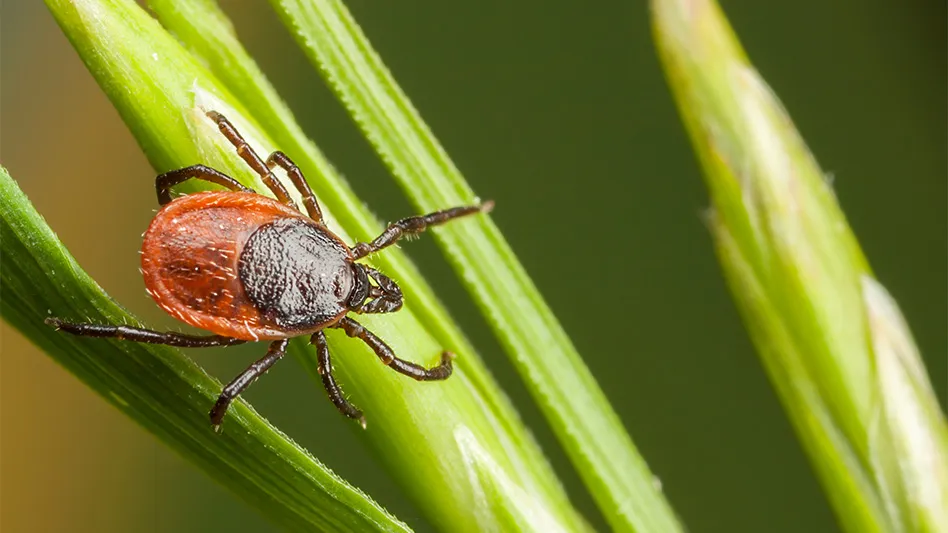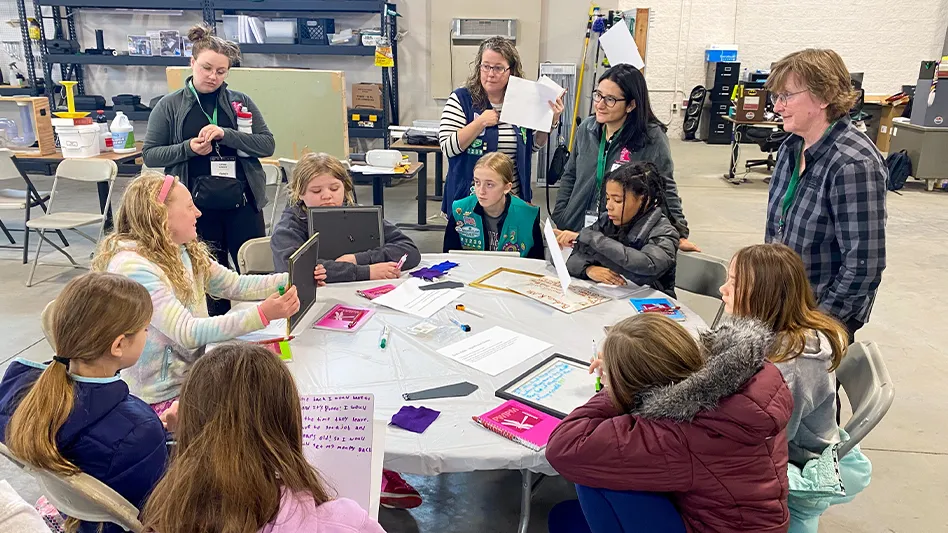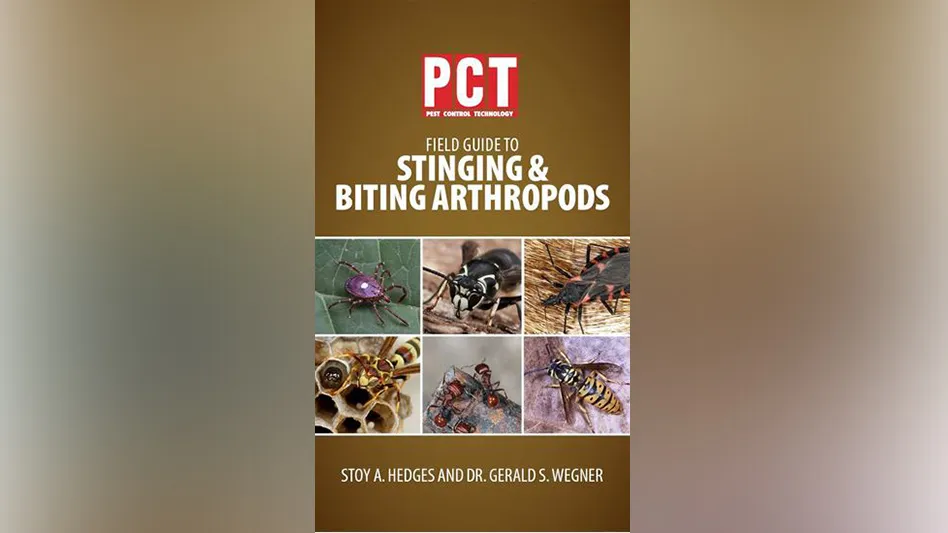The common pigeon, Columba livia, is the most important pest bird associated with inner-city schools in the city of Los Angeles. Schools are excellent nurturing and harboring places for large numbers of pigeons. They provide all of the critical necessities for pigeon survival and reproduction, including food, water, nesting and loafing sites. The noisy and dense diurnal human presence is also a deterrent to predators. Pigeons are highly adaptable and opportunistic birds that have found the human-created asphalt jungle habitat of inner-city schools much to their liking.
FOOD. Pigeons that frequent inner-city schools are a breed apart. They are unique in their intelligence and opportunistic behavior. They have learned the times of day when food is available at the schools and they arrive at food locations like clockwork. School building and grounds workers are familiar with the precise sequence of pigeon activity at various schools. Some of these employees have sarcastically stated that the pigeons are wearing watches while others have emphatically stated that the pigeons are tuned in to the school bell that announces nutrition breaks and lunch periods. One astute worker referred to the birds as "Pavlov’s pigeons."
Pigeon populations at inner-city schools reach their highest densities during lunch periods. Most of Los Angeles inner-city schools are overcrowded and outdoor lunch areas at many schools can only accommodate a fixed number of students at one time. As a result, lunch periods have to be staggered or extended to cater to all the pupils. This affords school pigeons a prolonged opportunity to capitalize on an abundant food source. This transient food availability has forced and conditioned inner-city school pigeons to become focused and targeted and to seek out the food with a sense of urgency and purpose.
Over time, school pigeons have learned that students will not harm them and they have habituated themselves to search for food within a few feet of the children. School pigeons have no fear of inner-city school pupils and they are frequently seen foraging under and between lunch tables and briskly walking between students’ feet under lunch tables. School staff and students have observed certain pigeons with deformed feet or characteristic coloration being at the same school at about the same time of day over a protracted period of time. This type of fidelity to specific time schedules is indicative of circadian rhythm behavior.
It should be noted that inner-city school pigeons may have also learned to associate heavy human presence, their noise and activity, etc., with the availability of food. School pigeons are not present in appreciable numbers on holidays and weekends when people are not present at the schools, even though the bells still ring on schedule.
OTHER RESOURCES AVAILABLE. There are many resources at many schools of which pigeons can take advantage.
Water. School policy dictates that trash be removed and the lunch area cleaned and washed after lunch. This washing is done with a pressure water hose whereby the tops of the lunch tables and the hardscape areas below are hosed down. School pigeons love this daily washing because it concentrates the small food particles and it provides them with a copious and reliable supply of good, clean water to drink. I have observed school pigeons turning their heads sideways in order to drink water from shallow water films on the tops of lunch tables. Pigeons have been seen following the water flow from the lunch area out to the street feeding in and drinking from it (see photo at left). Inner-city school pigeons appear to "hang around" after their lunch feeding frenzy for the washing process to commence so that they can obtain a thorough drink of water before they leave the area.
Nesting and loafing sites. Many Los Angeles inner-city schools were constructed in the early 1900s. These schools were built without any consideration given to conditions that are conducive to pigeon nesting, roosting and loafing. In short, pigeon nesting, roosting and loafing sites are ubiquitous in and on these school buildings. The tops of air conditioning units that are attached to exterior walls of school buildings are favorite nesting sites of pigeons. The undersides of large and numerous air conditioning units that are commonly found on flat roofs of school structures often harbor numerous pigeon nests, eggs, squabs, feathers and feces.
Protection from predators. Because of their locations, inner-city schools and their surrounding areas do not harbor important aerial predators of pigeons. On rare occasions, hawks have been seen taking adult and fledgling pigeons at isolated inner-city schools. Crows have occasionally been observed stealing pigeon eggs and killing and eating squabs at a few schools. The plant manager of one school, which has many tall trees on the premises, reported seeing a peregrine falcon taking pigeons at that school on several occasions. However, none of these avian predators are capable of appreciably reducing pigeon populations at inner-city schools. Feral cats have been seen killing and eating pigeons on school grounds at night.
Inner-city schools are unique asphalt jungle environments as far as wild animal populations are concerned. The heavy diurnal activity of large numbers of students, staff, faculty, administrators and their accompanying vehicles, equipment and human noise are not conducive to the presence of daytime pigeon predators.
STRATEGIES AT SCHOOLS. Following are some tips that pest management professionals can implement when performing pigeon management at schools.
Nest destruction. Inspecting affected schools every two weeks and locating and destroying pigeon nests can be helpful in dealing with an infestation. However, this strategy is labor intensive and costly and it takes time to see appreciable results. It can still be an effective supplement to other aggressive control strategies. Many pigeons that forage at inner-city schools often nest and roost elsewhere and nest removal and destruction is not likely to deplete the pigeon populations at these schools. However, it is important that nests on school property be periodically removed to prevent biting incidences by pigeon ectoparasites and a build-up of stored product pests that could subsequently invade the buildings.
Sanitation. It is unlikely that sanitation can be improved so as to impact pigeon populations at inner-city schools. The building and grounds workers are currently doing a good job of maintaining sanitation vigilance. Pigeons at these schools obtain most of their food during lunch periods from food scraps that fall off lunch tables and foods that are tossed to them by kids.
Pigeons are often these children’s only exposure to wildlife and they frequently treat these birds as pets. Educating the children about the hazards and diseases associated with pigeons may deter them from feeding these birds and thus encouraging them to hang around.
BIRD-PROOFING STRUCTURES. Bird netting is extremely useful in excluding pigeons from certain critical areas. For example, netting the undersides of roofs over lunch tables will prevent pigeons from perching there and dropping feces and feathers below on children and their food.
Bird netting excludes birds from an area but it does not reduce a pestiferous bird population. Pigeons denied access to an area simply go somewhere else. There is no shortage of alternative nesting, roosting and loafing sites for pigeons at inner-city schools. It is simply too costly and labor intensive to net off all the areas that need netting on school facilities. Even if that was possible, pigeons will still fly in from neighboring areas to forage at the schools. Hardware cloth and various other forms of rust-proof wire mesh also can be used to deny pigeons access to certain small areas.
Bird spikes. Pointed spikes and various other forms of anti-landing projections can prevent pigeons from perching at their favorite vantage locations. When pigeons arrive at an inner-city school lunch area, they more often than not perch at strategic vista points on adjacent roof edges in order to acquire a panoramic view of the foraging area below. From these vantage points, they survey the area below and decide where they are going to descend to begin scavenging on the hardscape. These vantage points can be taken away from them by the installation of bird spikes, bird coils, bird wires, etc. Vantage points are easy to locate by observing pigeon behavior during lunch time.
I have seen thousands of lineal feet of bird spikes installed at various schools that had no impact on the pigeon population. They simply move birds from one location to another. Bird spikes will deny pigeons access to certain critical areas, for example, on roof edges and pipes above entry doorways from where they can foul the hardscapes below and make fecal deposits on people entering and leaving buildings. Bird spikes are useful tools that can be effectively used as one facet of an integrated pigeon management program. They cannot be relied on by themselves to solve pigeon problems at inner-city schools.
Mechanical bird deterrent devices only discourage birds from landing and perching on certain areas where the devices are installed. They do not negatively impact a pigeon population. If there were 200 pigeons present at the school before these devices were installed, there will be 200 pigeons present after the devices were installed with the exception that the birds will now be resting, landing, perching and loafing on other areas.
Physical bird deterrent wires and spikes are also prone to damage and vandalism at inner-city schools even when they are installed on roof edges. I have observed children using basketballs, volleyballs, soccer balls, etc., to damage and knock bird deterrent devices off structures. As a result, these devices require periodic inspection and ongoing maintenance, which entails additional labor costs.
Gel repellents. Nontoxic, sticky gel repellents can be used to deter pigeons from landing and/or loafing on certain areas. When placed on edges of roofs of single-story buildings surrounding lunch areas of schools to prevent pigeons from using these vantage points, these sticky gels occasionally become a problem. Volleyballs, soccer balls, basketballs, etc., that are inadvertently knocked or thrown on top of the roofs often come back down with the tacky gels on them. This sometimes alarms students, teachers, coaches and administrators who often think the worst of this unknown tacky substance.
Bird repellent gels are short-term deterrents because they lose their effectiveness over time as a result of the accumulation of dust and debris on them.
Live trapping. Live trapping of pigeons can be a useful control strategy. However, it is not effective as a stand-alone control method. It is time-consuming and labor intensive because traps must to be monitored and serviced frequently for efficiency and humane purposes.
Disposing of trapped pigeons in Los Angeles County is a major issue. The City of Los Angeles, Department of Animal Services, which operates seven shelters, is not receptive to disposing of pigeons that are trapped and brought to them by pest control operators. Animal shelters sometimes take live pigeons from pest management professionals and then release them again once he or she leaves. Trapped birds should not be released within their homing range because pigeons have an excellent homing ability and they will fly back to where they were trapped in short order.
Avicide. Avitrol (4-aminopyridine), is a flock-frightening material, which when used properly, can be an effective pigeon dispersal tool. In my opinion, there are several negative issues associated with the use of 4-aminopyridine for pigeon control. Some of these issues are:
• Avitrol is lethal to most birds that consume enough bait to produce signs of intoxication.
• Birds which consume enough of this bait will display unusual behavior, hyperactivity, convulsions, violent thrashing about on the ground and other abnormal behavior that will be recognized by almost anyone as unusual behavior. Convulsing birds almost always attract attention from predators and humans.
• Avitrol "downed" birds can thrash about for almost an hour before they die.
• Even at the most conservative blend ratios of 1 to 29, one can anticipate about 5-7 percent mortality among the flock.
• Affected pigeons may fly considerable distances before exhibiting signs and dying. Occasionally, affected birds will die in flight and fall out of the sky. Pigeons may die in unintended high-profile areas. On one occasion, some pigeons baited at an elementary school died a block away at a high school. They were foraging at both of these sites.
• Responsible, trustworthy and vigilant people must be assigned to monitor Avitrol baiting areas and quickly retrieve convulsing, downed, dying and dead birds and properly dispose of them.
CONCLUSION. Schools are sensitive and unique environments with respect to any pest control activity. Serious and careful considerations must be given to the school environment and all other peripheral factors, such as potential public relations issues, before contemplating the use of Avitrol for pigeon control at inner-city schools. Most schools usually have a large student body. The overwhelming majority of these pupils will be extremely alarmed if they were to encounter a convulsing pigeon on school grounds.
Times have changed and society’s perceptions have changed. Today, misinformed and misguided people are quick to call the authorities on matters where they perceive adverse negative effects on animals as a result of control programs. However, when school pigeon populations reach densities where they pose a threat to human health and safety, Avitrol use may become warranted.
However, such a control program must be carefully planned and executed by knowledgeable people who can foresee all the potential negative possibilities. Good communication with all parties likely to be impacted are an absolute necessity when executing a pigeon control program that is likely to cause bird mortality.
It should be obvious from these issues that pigeon abatement at inner-city schools must be based on an IPM approach that carefully assesses and evaluates each problem site and employs control strategies that are appropriate to that location.
One-dimensional approaches to pigeon management at inner-city schools are doomed to fail. Reliance on physical bird deterrent devices alone will not produce desired results. Bird spikes, bird coils, bird wires, etc., simply move birds. They do not cause pigeons to leave a location where all of their necessities are abundant and readily available. Therefore, a well-balanced approach, using a variety of control techniques and tools, is the best strategy for PCOs who offer pigeon control services.
The author is an urban and structural entomologist and the IPM coordinator for the Los Angeles Unified School District. He can be reached via e-mail at hgulmahamad@pctonline.com.

Explore the October 2003 Issue
Check out more from this issue and find you next story to read.
Latest from Pest Control Technology
- Viking Pest Control Organizes a Charity Bike Build for Local Families
- Gaining Control of Structure-Infesting Carpenter Ants
- Big Blue Bug’s Brian Goldman Receives Rhode Island Small Business Person of the Year Award
- UF Researchers Examine How Much Bait it Takes to Eliminate a Subterranean Termite Colony
- Women in Pest Control Group Continues to Grow, Provide Opportunities in the Industry
- NPMA Announces Results of 2024-2025 Board of Directors Election
- Massey Services Acquires Orange Environmental Services
- Hawx Pest Control Wins Bronze Stevie Award for Sustainability





